Inconspicuous Consumption: Marketing Strategies for Elite Consumers
VerifiedAdded on 2020/09/08
|12
|4322
|276
Essay
AI Summary
This essay delves into the concept of inconspicuous consumption, examining the evolving spending habits of elite consumers who are increasingly opting for discreet, high-quality goods and services over traditional branded luxury items. It defines inconspicuous consumption, contrasting it with conspicuous consumption, and explores the factors driving this shift, including economic austerity and a desire to signal cultural capital. The study investigates how elite consumers allocate their resources, focusing on investments in education, services, and human capital. It also analyzes the implications of this trend for marketing strategies, including how companies can adapt to reach and engage with this discerning consumer group. The essay discusses the historical context of conspicuous consumption, from Thorstein Veblen's observations to the modern-day availability of luxury products and services. The analysis highlights the influence of social and cultural factors on consumer behavior, emphasizing the importance of understanding the values and preferences of elite consumers. The essay concludes with a discussion of the future of inconspicuous consumption, suggesting ongoing trends and potential areas for further research. This assignment is contributed by a student to Desklib, a platform providing AI-based study tools.
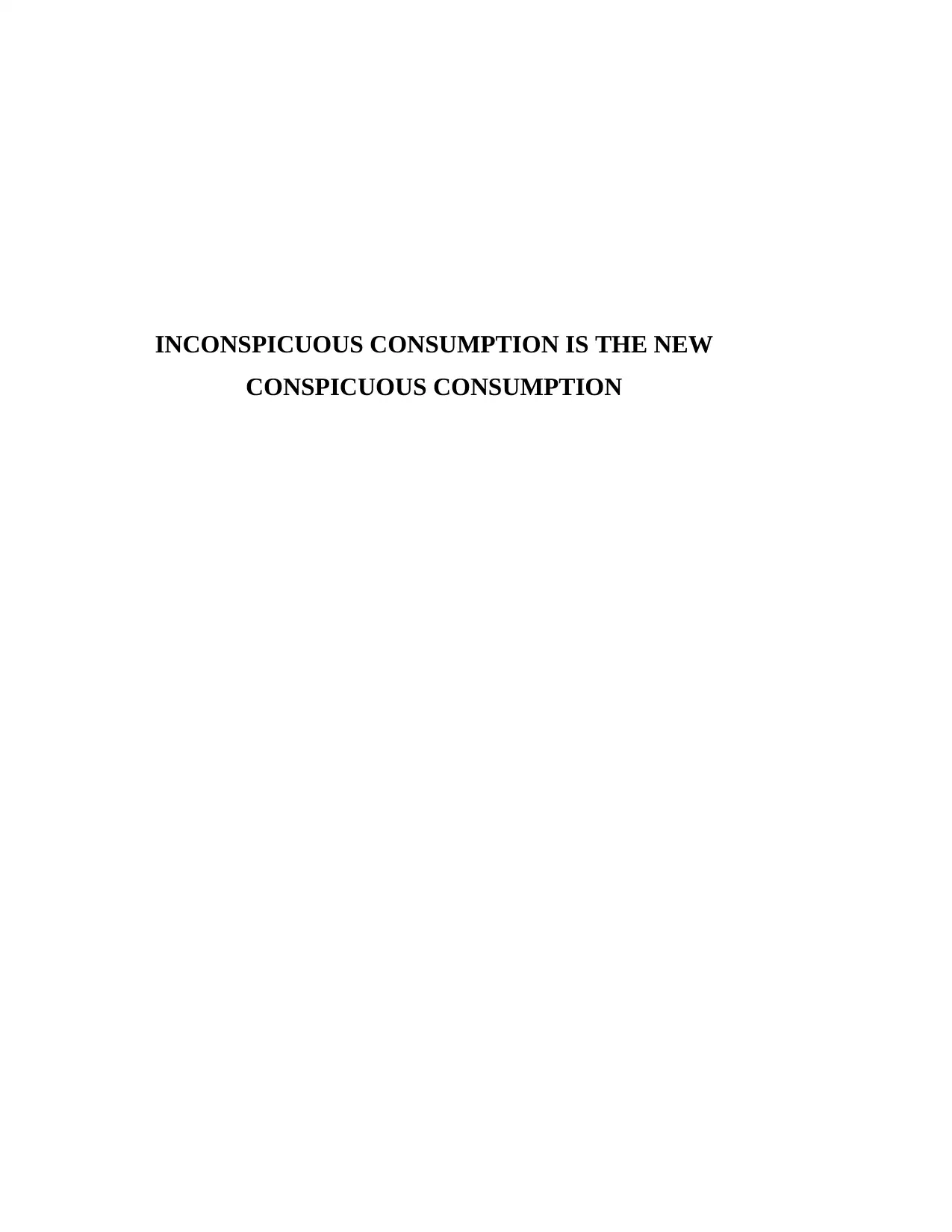
INCONSPICUOUS CONSUMPTION IS THE NEW
CONSPICUOUS CONSUMPTION
CONSPICUOUS CONSUMPTION
Paraphrase This Document
Need a fresh take? Get an instant paraphrase of this document with our AI Paraphraser
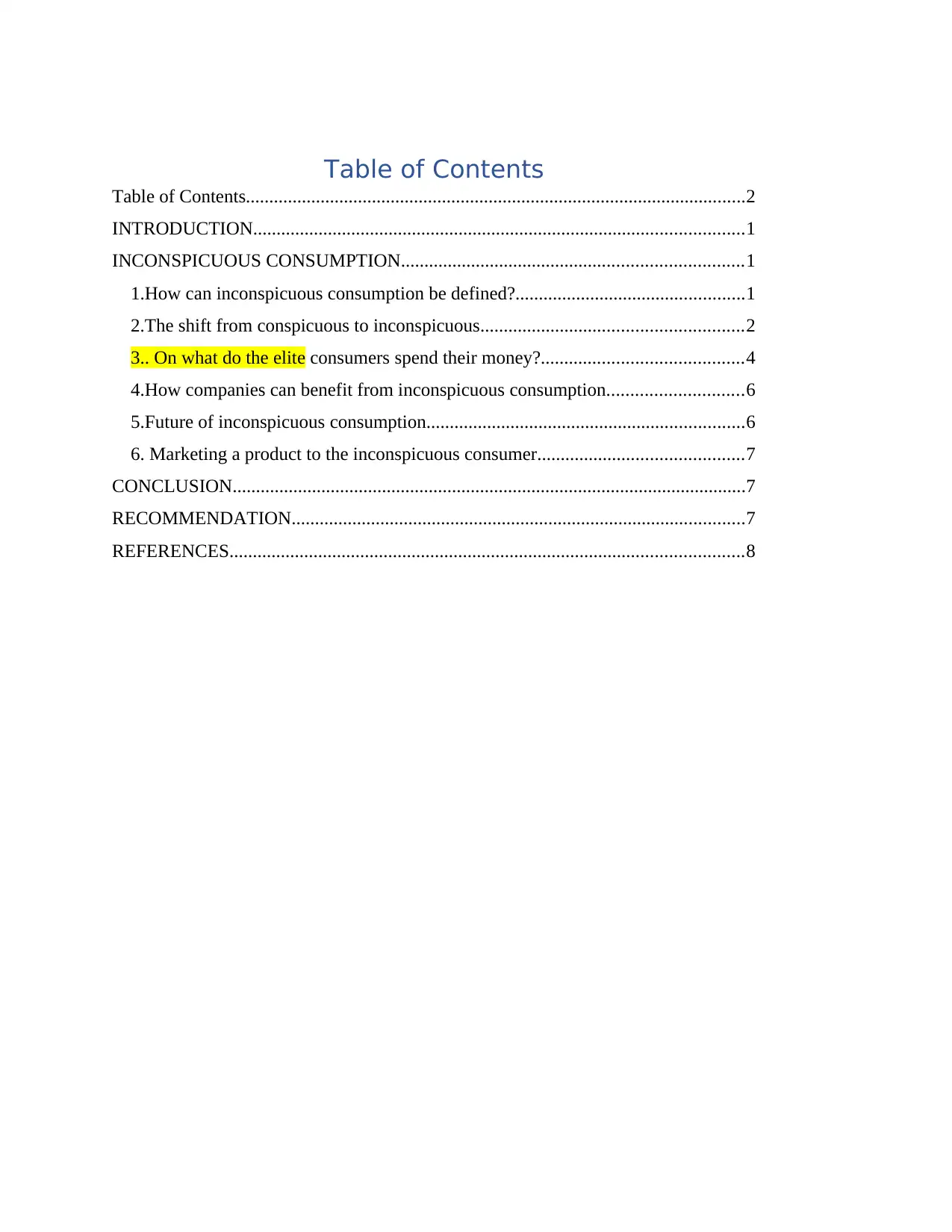
Table of Contents
Table of Contents...........................................................................................................2
INTRODUCTION.........................................................................................................1
INCONSPICUOUS CONSUMPTION.........................................................................1
1.How can inconspicuous consumption be defined?.................................................1
2.The shift from conspicuous to inconspicuous........................................................2
3.. On what do the elite consumers spend their money?...........................................4
4.How companies can benefit from inconspicuous consumption.............................6
5.Future of inconspicuous consumption....................................................................6
6. Marketing a product to the inconspicuous consumer............................................7
CONCLUSION..............................................................................................................7
RECOMMENDATION.................................................................................................7
REFERENCES..............................................................................................................8
Table of Contents...........................................................................................................2
INTRODUCTION.........................................................................................................1
INCONSPICUOUS CONSUMPTION.........................................................................1
1.How can inconspicuous consumption be defined?.................................................1
2.The shift from conspicuous to inconspicuous........................................................2
3.. On what do the elite consumers spend their money?...........................................4
4.How companies can benefit from inconspicuous consumption.............................6
5.Future of inconspicuous consumption....................................................................6
6. Marketing a product to the inconspicuous consumer............................................7
CONCLUSION..............................................................................................................7
RECOMMENDATION.................................................................................................7
REFERENCES..............................................................................................................8
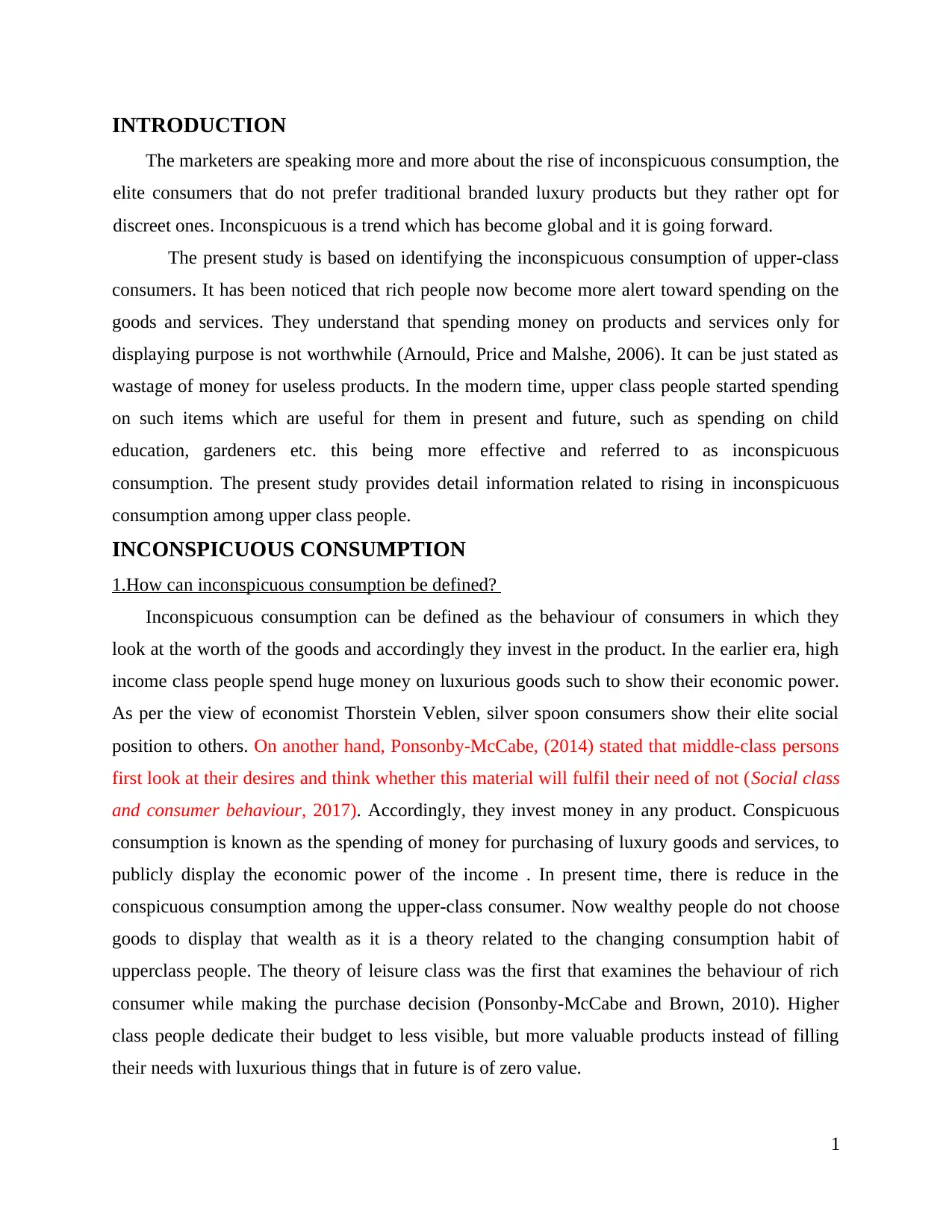
INTRODUCTION
The marketers are speaking more and more about the rise of inconspicuous consumption, the
elite consumers that do not prefer traditional branded luxury products but they rather opt for
discreet ones. Inconspicuous is a trend which has become global and it is going forward.
The present study is based on identifying the inconspicuous consumption of upper-class
consumers. It has been noticed that rich people now become more alert toward spending on the
goods and services. They understand that spending money on products and services only for
displaying purpose is not worthwhile (Arnould, Price and Malshe, 2006). It can be just stated as
wastage of money for useless products. In the modern time, upper class people started spending
on such items which are useful for them in present and future, such as spending on child
education, gardeners etc. this being more effective and referred to as inconspicuous
consumption. The present study provides detail information related to rising in inconspicuous
consumption among upper class people.
INCONSPICUOUS CONSUMPTION
1.How can inconspicuous consumption be defined?
Inconspicuous consumption can be defined as the behaviour of consumers in which they
look at the worth of the goods and accordingly they invest in the product. In the earlier era, high
income class people spend huge money on luxurious goods such to show their economic power.
As per the view of economist Thorstein Veblen, silver spoon consumers show their elite social
position to others. On another hand, Ponsonby-McCabe, (2014) stated that middle-class persons
first look at their desires and think whether this material will fulfil their need of not (Social class
and consumer behaviour, 2017). Accordingly, they invest money in any product. Conspicuous
consumption is known as the spending of money for purchasing of luxury goods and services, to
publicly display the economic power of the income . In present time, there is reduce in the
conspicuous consumption among the upper-class consumer. Now wealthy people do not choose
goods to display that wealth as it is a theory related to the changing consumption habit of
upperclass people. The theory of leisure class was the first that examines the behaviour of rich
consumer while making the purchase decision (Ponsonby-McCabe and Brown, 2010). Higher
class people dedicate their budget to less visible, but more valuable products instead of filling
their needs with luxurious things that in future is of zero value.
1
The marketers are speaking more and more about the rise of inconspicuous consumption, the
elite consumers that do not prefer traditional branded luxury products but they rather opt for
discreet ones. Inconspicuous is a trend which has become global and it is going forward.
The present study is based on identifying the inconspicuous consumption of upper-class
consumers. It has been noticed that rich people now become more alert toward spending on the
goods and services. They understand that spending money on products and services only for
displaying purpose is not worthwhile (Arnould, Price and Malshe, 2006). It can be just stated as
wastage of money for useless products. In the modern time, upper class people started spending
on such items which are useful for them in present and future, such as spending on child
education, gardeners etc. this being more effective and referred to as inconspicuous
consumption. The present study provides detail information related to rising in inconspicuous
consumption among upper class people.
INCONSPICUOUS CONSUMPTION
1.How can inconspicuous consumption be defined?
Inconspicuous consumption can be defined as the behaviour of consumers in which they
look at the worth of the goods and accordingly they invest in the product. In the earlier era, high
income class people spend huge money on luxurious goods such to show their economic power.
As per the view of economist Thorstein Veblen, silver spoon consumers show their elite social
position to others. On another hand, Ponsonby-McCabe, (2014) stated that middle-class persons
first look at their desires and think whether this material will fulfil their need of not (Social class
and consumer behaviour, 2017). Accordingly, they invest money in any product. Conspicuous
consumption is known as the spending of money for purchasing of luxury goods and services, to
publicly display the economic power of the income . In present time, there is reduce in the
conspicuous consumption among the upper-class consumer. Now wealthy people do not choose
goods to display that wealth as it is a theory related to the changing consumption habit of
upperclass people. The theory of leisure class was the first that examines the behaviour of rich
consumer while making the purchase decision (Ponsonby-McCabe and Brown, 2010). Higher
class people dedicate their budget to less visible, but more valuable products instead of filling
their needs with luxurious things that in future is of zero value.
1
⊘ This is a preview!⊘
Do you want full access?
Subscribe today to unlock all pages.

Trusted by 1+ million students worldwide

According to Eckhardt, Belk and Wilson, (2015) conspicuous consumption can be
defined as buying highly expensive goods to wasteful display wealth. These costly products are
unable to fulfil their needs but still people purchase it just to show their richness to others.
2.The shift from conspicuous to inconspicuous
As per the view of Dougan (2012) Conspicuous consumption represents the buying of
expensive goods only to show wealth and not to fulfil the consumer needs. Conspicuous
consumptions can be considered as unambiguous signal that can influence personal choice. It is
the sign that reflects social class of two different people. If person belongs from rich background
then individual can think to buy luxurious products but if person belongs from poor family then
they always prefer to buy such products that can satisfy their need. Changes from conspicuous to
inconspicuous consumption can be seen in luxury brands such as Louis Vuitton selling a sweater
with a knitted V pattern rather than using the easily identifiable logo. This may be because rich
people do not want to cause anger during economic austerity (Belk 2011;). They are creating
their status through creating a cultural capital and the spending habits that come with this. Over
than spending money on material goods, they rather use it for education, services and human
capital investment which have an impact on the quality of life and new generation future. The
shift from conspicuous to inconspicuous happened in three phases. First one is the traditional
conspicuous consumption, where expensive goods with visible brands, serve to affirm status. Wu
and et.al, (2017) argued that spending pattern of different people are different from each other.
For example black people have good income sources thus, they can spend money whatever they
want to buy thus, they need not to show their wealthy by buying costly products. Whereas there
are white people those have less income sources they try to show their status to other people
thus, they generally prefer to purchase costly products.
The second phase, in consumers eyes, ‘’luxury was losing its lustre’’ (Belk 2015). In the last
phase, the luxury brands become widely available.
The shift to inconspicuous consumption is even more visible in countries that were known as
predominantly conspicuous. Inconspicuous consumption has risen in China and Middle East
countries, this showing that this country is becoming wealthier.
As per the view of Walters and Carr, (2017) in the recent time buying luxurious products
cannot make social class. People like to buy more useful products rather than purchasing
conspicuous brand names. Lee, (2017) argued that racial impact on preferences of consumers.
2
defined as buying highly expensive goods to wasteful display wealth. These costly products are
unable to fulfil their needs but still people purchase it just to show their richness to others.
2.The shift from conspicuous to inconspicuous
As per the view of Dougan (2012) Conspicuous consumption represents the buying of
expensive goods only to show wealth and not to fulfil the consumer needs. Conspicuous
consumptions can be considered as unambiguous signal that can influence personal choice. It is
the sign that reflects social class of two different people. If person belongs from rich background
then individual can think to buy luxurious products but if person belongs from poor family then
they always prefer to buy such products that can satisfy their need. Changes from conspicuous to
inconspicuous consumption can be seen in luxury brands such as Louis Vuitton selling a sweater
with a knitted V pattern rather than using the easily identifiable logo. This may be because rich
people do not want to cause anger during economic austerity (Belk 2011;). They are creating
their status through creating a cultural capital and the spending habits that come with this. Over
than spending money on material goods, they rather use it for education, services and human
capital investment which have an impact on the quality of life and new generation future. The
shift from conspicuous to inconspicuous happened in three phases. First one is the traditional
conspicuous consumption, where expensive goods with visible brands, serve to affirm status. Wu
and et.al, (2017) argued that spending pattern of different people are different from each other.
For example black people have good income sources thus, they can spend money whatever they
want to buy thus, they need not to show their wealthy by buying costly products. Whereas there
are white people those have less income sources they try to show their status to other people
thus, they generally prefer to purchase costly products.
The second phase, in consumers eyes, ‘’luxury was losing its lustre’’ (Belk 2015). In the last
phase, the luxury brands become widely available.
The shift to inconspicuous consumption is even more visible in countries that were known as
predominantly conspicuous. Inconspicuous consumption has risen in China and Middle East
countries, this showing that this country is becoming wealthier.
As per the view of Walters and Carr, (2017) in the recent time buying luxurious products
cannot make social class. People like to buy more useful products rather than purchasing
conspicuous brand names. Lee, (2017) argued that racial impact on preferences of consumers.
2
Paraphrase This Document
Need a fresh take? Get an instant paraphrase of this document with our AI Paraphraser
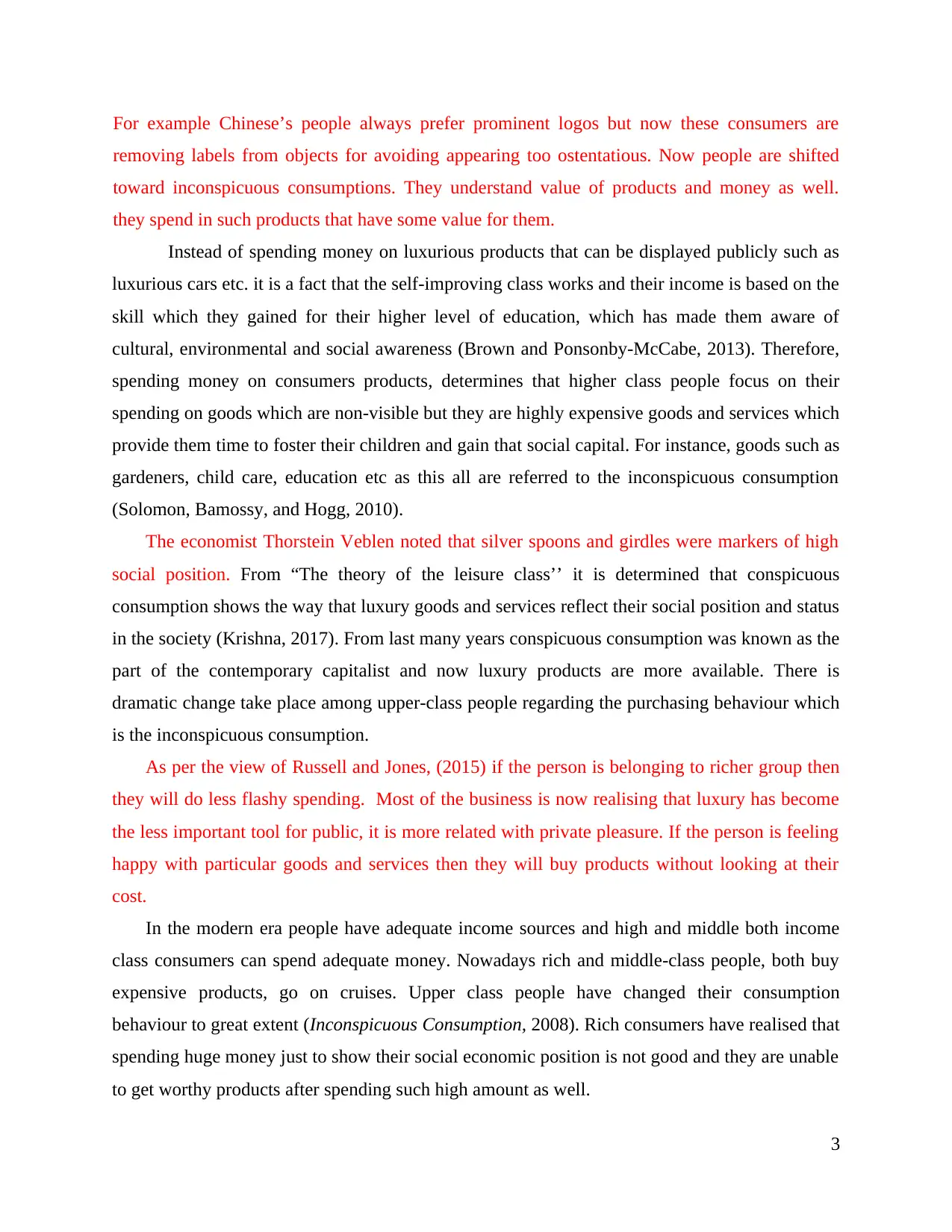
For example Chinese’s people always prefer prominent logos but now these consumers are
removing labels from objects for avoiding appearing too ostentatious. Now people are shifted
toward inconspicuous consumptions. They understand value of products and money as well.
they spend in such products that have some value for them.
Instead of spending money on luxurious products that can be displayed publicly such as
luxurious cars etc. it is a fact that the self-improving class works and their income is based on the
skill which they gained for their higher level of education, which has made them aware of
cultural, environmental and social awareness (Brown and Ponsonby-McCabe, 2013). Therefore,
spending money on consumers products, determines that higher class people focus on their
spending on goods which are non-visible but they are highly expensive goods and services which
provide them time to foster their children and gain that social capital. For instance, goods such as
gardeners, child care, education etc as this all are referred to the inconspicuous consumption
(Solomon, Bamossy, and Hogg, 2010).
The economist Thorstein Veblen noted that silver spoons and girdles were markers of high
social position. From “The theory of the leisure class’’ it is determined that conspicuous
consumption shows the way that luxury goods and services reflect their social position and status
in the society (Krishna, 2017). From last many years conspicuous consumption was known as the
part of the contemporary capitalist and now luxury products are more available. There is
dramatic change take place among upper-class people regarding the purchasing behaviour which
is the inconspicuous consumption.
As per the view of Russell and Jones, (2015) if the person is belonging to richer group then
they will do less flashy spending. Most of the business is now realising that luxury has become
the less important tool for public, it is more related with private pleasure. If the person is feeling
happy with particular goods and services then they will buy products without looking at their
cost.
In the modern era people have adequate income sources and high and middle both income
class consumers can spend adequate money. Nowadays rich and middle-class people, both buy
expensive products, go on cruises. Upper class people have changed their consumption
behaviour to great extent (Inconspicuous Consumption, 2008). Rich consumers have realised that
spending huge money just to show their social economic position is not good and they are unable
to get worthy products after spending such high amount as well.
3
removing labels from objects for avoiding appearing too ostentatious. Now people are shifted
toward inconspicuous consumptions. They understand value of products and money as well.
they spend in such products that have some value for them.
Instead of spending money on luxurious products that can be displayed publicly such as
luxurious cars etc. it is a fact that the self-improving class works and their income is based on the
skill which they gained for their higher level of education, which has made them aware of
cultural, environmental and social awareness (Brown and Ponsonby-McCabe, 2013). Therefore,
spending money on consumers products, determines that higher class people focus on their
spending on goods which are non-visible but they are highly expensive goods and services which
provide them time to foster their children and gain that social capital. For instance, goods such as
gardeners, child care, education etc as this all are referred to the inconspicuous consumption
(Solomon, Bamossy, and Hogg, 2010).
The economist Thorstein Veblen noted that silver spoons and girdles were markers of high
social position. From “The theory of the leisure class’’ it is determined that conspicuous
consumption shows the way that luxury goods and services reflect their social position and status
in the society (Krishna, 2017). From last many years conspicuous consumption was known as the
part of the contemporary capitalist and now luxury products are more available. There is
dramatic change take place among upper-class people regarding the purchasing behaviour which
is the inconspicuous consumption.
As per the view of Russell and Jones, (2015) if the person is belonging to richer group then
they will do less flashy spending. Most of the business is now realising that luxury has become
the less important tool for public, it is more related with private pleasure. If the person is feeling
happy with particular goods and services then they will buy products without looking at their
cost.
In the modern era people have adequate income sources and high and middle both income
class consumers can spend adequate money. Nowadays rich and middle-class people, both buy
expensive products, go on cruises. Upper class people have changed their consumption
behaviour to great extent (Inconspicuous Consumption, 2008). Rich consumers have realised that
spending huge money just to show their social economic position is not good and they are unable
to get worthy products after spending such high amount as well.
3
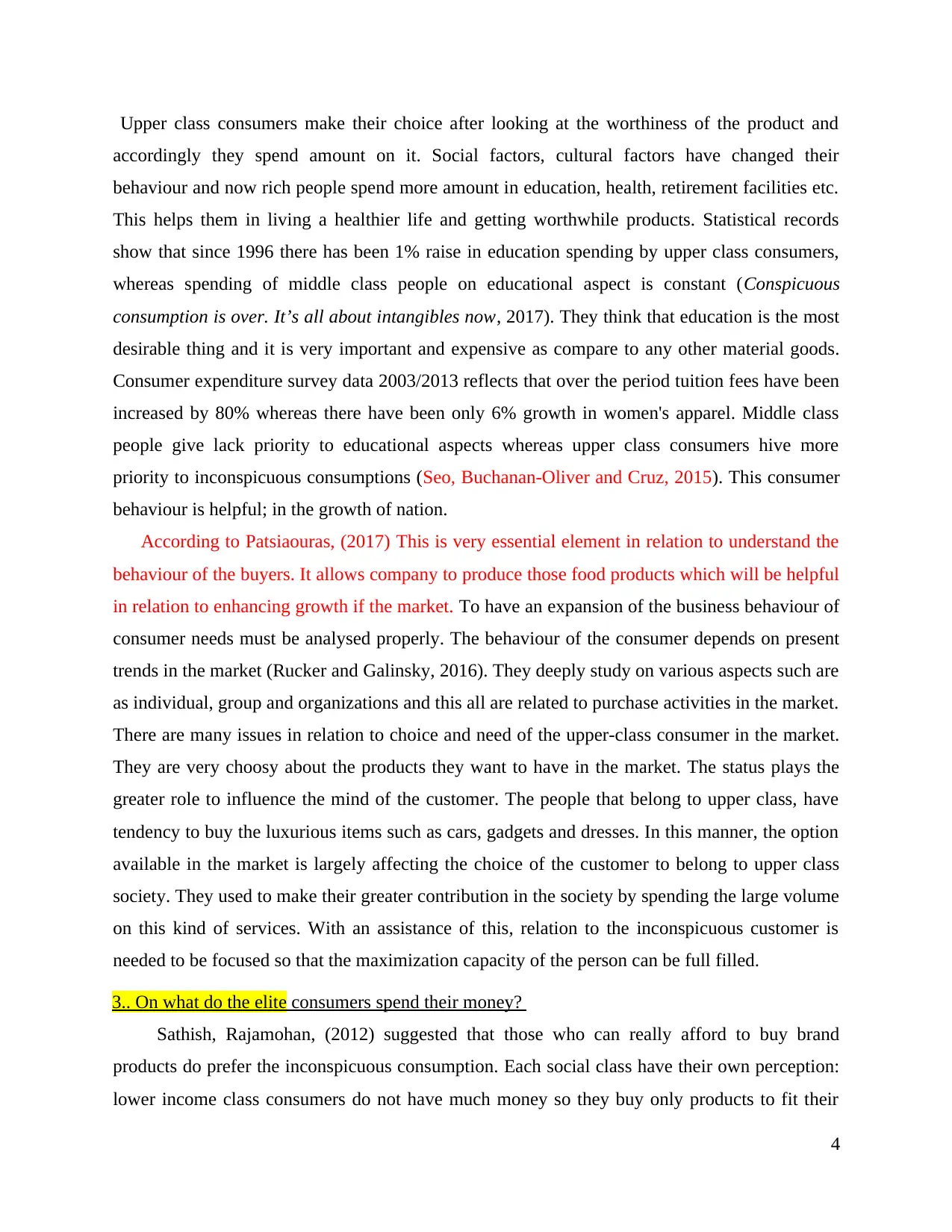
Upper class consumers make their choice after looking at the worthiness of the product and
accordingly they spend amount on it. Social factors, cultural factors have changed their
behaviour and now rich people spend more amount in education, health, retirement facilities etc.
This helps them in living a healthier life and getting worthwhile products. Statistical records
show that since 1996 there has been 1% raise in education spending by upper class consumers,
whereas spending of middle class people on educational aspect is constant (Conspicuous
consumption is over. It’s all about intangibles now, 2017). They think that education is the most
desirable thing and it is very important and expensive as compare to any other material goods.
Consumer expenditure survey data 2003/2013 reflects that over the period tuition fees have been
increased by 80% whereas there have been only 6% growth in women's apparel. Middle class
people give lack priority to educational aspects whereas upper class consumers hive more
priority to inconspicuous consumptions (Seo, Buchanan-Oliver and Cruz, 2015). This consumer
behaviour is helpful; in the growth of nation.
According to Patsiaouras, (2017) This is very essential element in relation to understand the
behaviour of the buyers. It allows company to produce those food products which will be helpful
in relation to enhancing growth if the market. To have an expansion of the business behaviour of
consumer needs must be analysed properly. The behaviour of the consumer depends on present
trends in the market (Rucker and Galinsky, 2016). They deeply study on various aspects such are
as individual, group and organizations and this all are related to purchase activities in the market.
There are many issues in relation to choice and need of the upper-class consumer in the market.
They are very choosy about the products they want to have in the market. The status plays the
greater role to influence the mind of the customer. The people that belong to upper class, have
tendency to buy the luxurious items such as cars, gadgets and dresses. In this manner, the option
available in the market is largely affecting the choice of the customer to belong to upper class
society. They used to make their greater contribution in the society by spending the large volume
on this kind of services. With an assistance of this, relation to the inconspicuous customer is
needed to be focused so that the maximization capacity of the person can be full filled.
3.. On what do the elite consumers spend their money?
Sathish, Rajamohan, (2012) suggested that those who can really afford to buy brand
products do prefer the inconspicuous consumption. Each social class have their own perception:
lower income class consumers do not have much money so they buy only products to fit their
4
accordingly they spend amount on it. Social factors, cultural factors have changed their
behaviour and now rich people spend more amount in education, health, retirement facilities etc.
This helps them in living a healthier life and getting worthwhile products. Statistical records
show that since 1996 there has been 1% raise in education spending by upper class consumers,
whereas spending of middle class people on educational aspect is constant (Conspicuous
consumption is over. It’s all about intangibles now, 2017). They think that education is the most
desirable thing and it is very important and expensive as compare to any other material goods.
Consumer expenditure survey data 2003/2013 reflects that over the period tuition fees have been
increased by 80% whereas there have been only 6% growth in women's apparel. Middle class
people give lack priority to educational aspects whereas upper class consumers hive more
priority to inconspicuous consumptions (Seo, Buchanan-Oliver and Cruz, 2015). This consumer
behaviour is helpful; in the growth of nation.
According to Patsiaouras, (2017) This is very essential element in relation to understand the
behaviour of the buyers. It allows company to produce those food products which will be helpful
in relation to enhancing growth if the market. To have an expansion of the business behaviour of
consumer needs must be analysed properly. The behaviour of the consumer depends on present
trends in the market (Rucker and Galinsky, 2016). They deeply study on various aspects such are
as individual, group and organizations and this all are related to purchase activities in the market.
There are many issues in relation to choice and need of the upper-class consumer in the market.
They are very choosy about the products they want to have in the market. The status plays the
greater role to influence the mind of the customer. The people that belong to upper class, have
tendency to buy the luxurious items such as cars, gadgets and dresses. In this manner, the option
available in the market is largely affecting the choice of the customer to belong to upper class
society. They used to make their greater contribution in the society by spending the large volume
on this kind of services. With an assistance of this, relation to the inconspicuous customer is
needed to be focused so that the maximization capacity of the person can be full filled.
3.. On what do the elite consumers spend their money?
Sathish, Rajamohan, (2012) suggested that those who can really afford to buy brand
products do prefer the inconspicuous consumption. Each social class have their own perception:
lower income class consumers do not have much money so they buy only products to fit their
4
⊘ This is a preview!⊘
Do you want full access?
Subscribe today to unlock all pages.

Trusted by 1+ million students worldwide
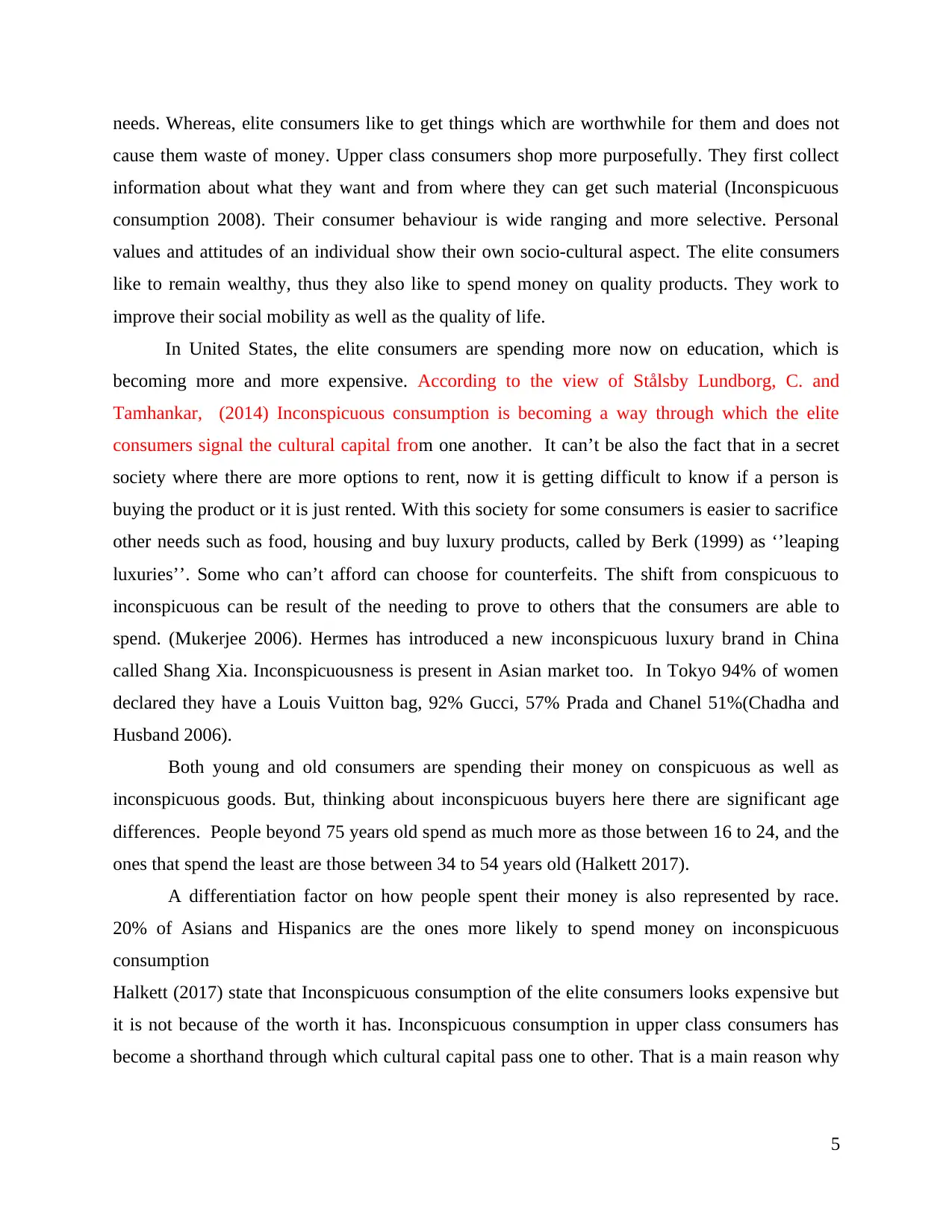
needs. Whereas, elite consumers like to get things which are worthwhile for them and does not
cause them waste of money. Upper class consumers shop more purposefully. They first collect
information about what they want and from where they can get such material (Inconspicuous
consumption 2008). Their consumer behaviour is wide ranging and more selective. Personal
values and attitudes of an individual show their own socio-cultural aspect. The elite consumers
like to remain wealthy, thus they also like to spend money on quality products. They work to
improve their social mobility as well as the quality of life.
In United States, the elite consumers are spending more now on education, which is
becoming more and more expensive. According to the view of Stålsby Lundborg, C. and
Tamhankar, (2014) Inconspicuous consumption is becoming a way through which the elite
consumers signal the cultural capital from one another. It can’t be also the fact that in a secret
society where there are more options to rent, now it is getting difficult to know if a person is
buying the product or it is just rented. With this society for some consumers is easier to sacrifice
other needs such as food, housing and buy luxury products, called by Berk (1999) as ‘’leaping
luxuries’’. Some who can’t afford can choose for counterfeits. The shift from conspicuous to
inconspicuous can be result of the needing to prove to others that the consumers are able to
spend. (Mukerjee 2006). Hermes has introduced a new inconspicuous luxury brand in China
called Shang Xia. Inconspicuousness is present in Asian market too. In Tokyo 94% of women
declared they have a Louis Vuitton bag, 92% Gucci, 57% Prada and Chanel 51%(Chadha and
Husband 2006).
Both young and old consumers are spending their money on conspicuous as well as
inconspicuous goods. But, thinking about inconspicuous buyers here there are significant age
differences. People beyond 75 years old spend as much more as those between 16 to 24, and the
ones that spend the least are those between 34 to 54 years old (Halkett 2017).
A differentiation factor on how people spent their money is also represented by race.
20% of Asians and Hispanics are the ones more likely to spend money on inconspicuous
consumption
Halkett (2017) state that Inconspicuous consumption of the elite consumers looks expensive but
it is not because of the worth it has. Inconspicuous consumption in upper class consumers has
become a shorthand through which cultural capital pass one to other. That is a main reason why
5
cause them waste of money. Upper class consumers shop more purposefully. They first collect
information about what they want and from where they can get such material (Inconspicuous
consumption 2008). Their consumer behaviour is wide ranging and more selective. Personal
values and attitudes of an individual show their own socio-cultural aspect. The elite consumers
like to remain wealthy, thus they also like to spend money on quality products. They work to
improve their social mobility as well as the quality of life.
In United States, the elite consumers are spending more now on education, which is
becoming more and more expensive. According to the view of Stålsby Lundborg, C. and
Tamhankar, (2014) Inconspicuous consumption is becoming a way through which the elite
consumers signal the cultural capital from one another. It can’t be also the fact that in a secret
society where there are more options to rent, now it is getting difficult to know if a person is
buying the product or it is just rented. With this society for some consumers is easier to sacrifice
other needs such as food, housing and buy luxury products, called by Berk (1999) as ‘’leaping
luxuries’’. Some who can’t afford can choose for counterfeits. The shift from conspicuous to
inconspicuous can be result of the needing to prove to others that the consumers are able to
spend. (Mukerjee 2006). Hermes has introduced a new inconspicuous luxury brand in China
called Shang Xia. Inconspicuousness is present in Asian market too. In Tokyo 94% of women
declared they have a Louis Vuitton bag, 92% Gucci, 57% Prada and Chanel 51%(Chadha and
Husband 2006).
Both young and old consumers are spending their money on conspicuous as well as
inconspicuous goods. But, thinking about inconspicuous buyers here there are significant age
differences. People beyond 75 years old spend as much more as those between 16 to 24, and the
ones that spend the least are those between 34 to 54 years old (Halkett 2017).
A differentiation factor on how people spent their money is also represented by race.
20% of Asians and Hispanics are the ones more likely to spend money on inconspicuous
consumption
Halkett (2017) state that Inconspicuous consumption of the elite consumers looks expensive but
it is not because of the worth it has. Inconspicuous consumption in upper class consumers has
become a shorthand through which cultural capital pass one to other. That is a main reason why
5
Paraphrase This Document
Need a fresh take? Get an instant paraphrase of this document with our AI Paraphraser
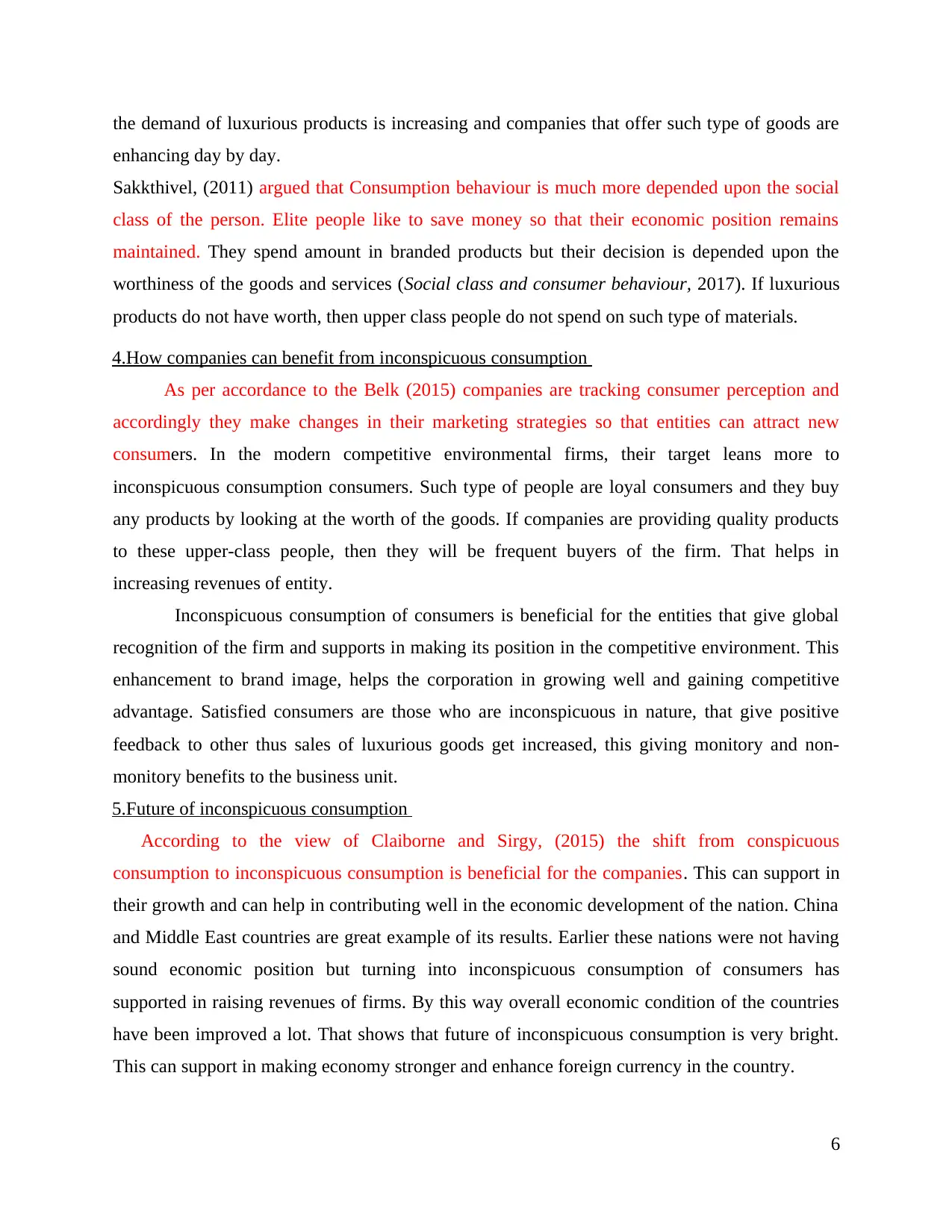
the demand of luxurious products is increasing and companies that offer such type of goods are
enhancing day by day.
Sakkthivel, (2011) argued that Consumption behaviour is much more depended upon the social
class of the person. Elite people like to save money so that their economic position remains
maintained. They spend amount in branded products but their decision is depended upon the
worthiness of the goods and services (Social class and consumer behaviour, 2017). If luxurious
products do not have worth, then upper class people do not spend on such type of materials.
4.How companies can benefit from inconspicuous consumption
As per accordance to the Belk (2015) companies are tracking consumer perception and
accordingly they make changes in their marketing strategies so that entities can attract new
consumers. In the modern competitive environmental firms, their target leans more to
inconspicuous consumption consumers. Such type of people are loyal consumers and they buy
any products by looking at the worth of the goods. If companies are providing quality products
to these upper-class people, then they will be frequent buyers of the firm. That helps in
increasing revenues of entity.
Inconspicuous consumption of consumers is beneficial for the entities that give global
recognition of the firm and supports in making its position in the competitive environment. This
enhancement to brand image, helps the corporation in growing well and gaining competitive
advantage. Satisfied consumers are those who are inconspicuous in nature, that give positive
feedback to other thus sales of luxurious goods get increased, this giving monitory and non-
monitory benefits to the business unit.
5.Future of inconspicuous consumption
According to the view of Claiborne and Sirgy, (2015) the shift from conspicuous
consumption to inconspicuous consumption is beneficial for the companies. This can support in
their growth and can help in contributing well in the economic development of the nation. China
and Middle East countries are great example of its results. Earlier these nations were not having
sound economic position but turning into inconspicuous consumption of consumers has
supported in raising revenues of firms. By this way overall economic condition of the countries
have been improved a lot. That shows that future of inconspicuous consumption is very bright.
This can support in making economy stronger and enhance foreign currency in the country.
6
enhancing day by day.
Sakkthivel, (2011) argued that Consumption behaviour is much more depended upon the social
class of the person. Elite people like to save money so that their economic position remains
maintained. They spend amount in branded products but their decision is depended upon the
worthiness of the goods and services (Social class and consumer behaviour, 2017). If luxurious
products do not have worth, then upper class people do not spend on such type of materials.
4.How companies can benefit from inconspicuous consumption
As per accordance to the Belk (2015) companies are tracking consumer perception and
accordingly they make changes in their marketing strategies so that entities can attract new
consumers. In the modern competitive environmental firms, their target leans more to
inconspicuous consumption consumers. Such type of people are loyal consumers and they buy
any products by looking at the worth of the goods. If companies are providing quality products
to these upper-class people, then they will be frequent buyers of the firm. That helps in
increasing revenues of entity.
Inconspicuous consumption of consumers is beneficial for the entities that give global
recognition of the firm and supports in making its position in the competitive environment. This
enhancement to brand image, helps the corporation in growing well and gaining competitive
advantage. Satisfied consumers are those who are inconspicuous in nature, that give positive
feedback to other thus sales of luxurious goods get increased, this giving monitory and non-
monitory benefits to the business unit.
5.Future of inconspicuous consumption
According to the view of Claiborne and Sirgy, (2015) the shift from conspicuous
consumption to inconspicuous consumption is beneficial for the companies. This can support in
their growth and can help in contributing well in the economic development of the nation. China
and Middle East countries are great example of its results. Earlier these nations were not having
sound economic position but turning into inconspicuous consumption of consumers has
supported in raising revenues of firms. By this way overall economic condition of the countries
have been improved a lot. That shows that future of inconspicuous consumption is very bright.
This can support in making economy stronger and enhance foreign currency in the country.
6
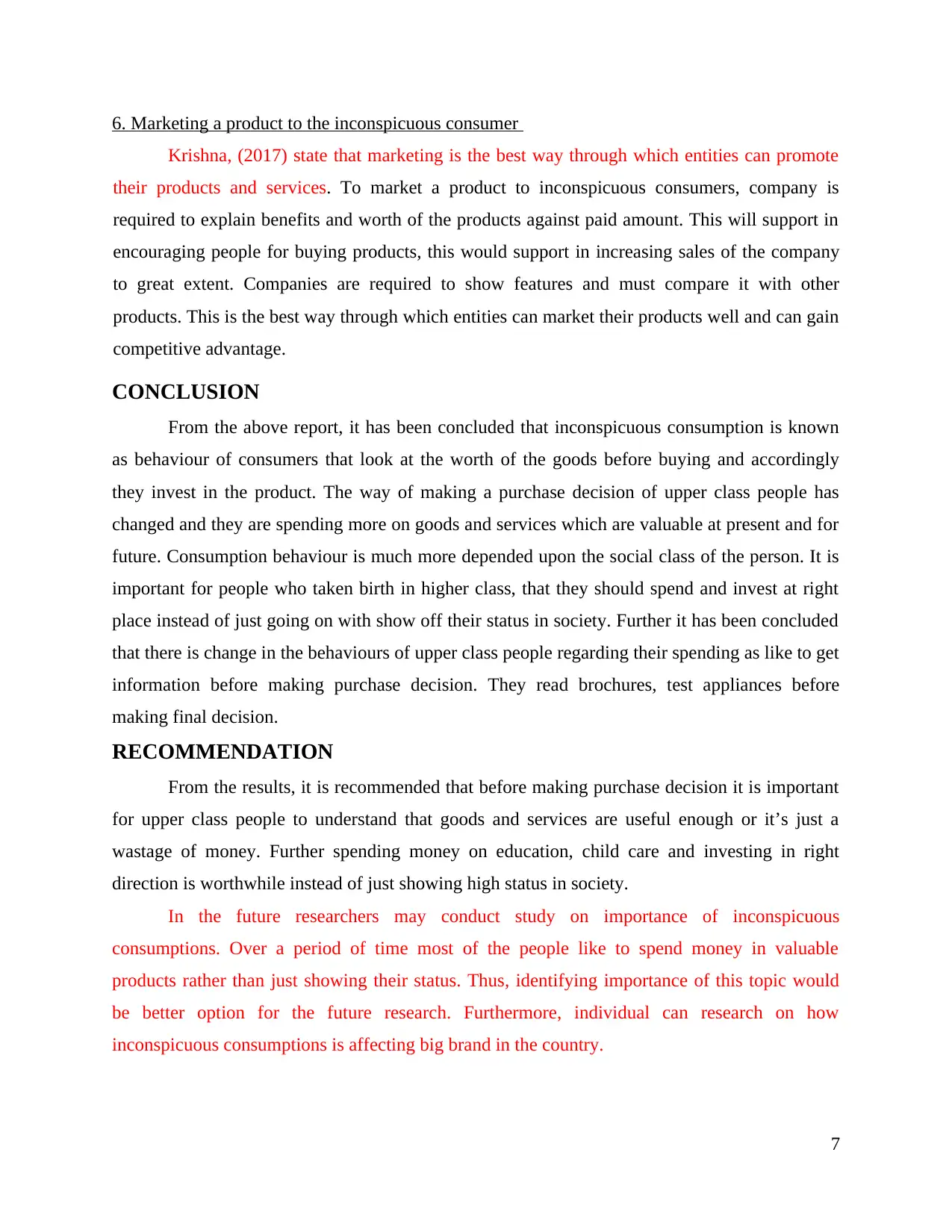
6. Marketing a product to the inconspicuous consumer
Krishna, (2017) state that marketing is the best way through which entities can promote
their products and services. To market a product to inconspicuous consumers, company is
required to explain benefits and worth of the products against paid amount. This will support in
encouraging people for buying products, this would support in increasing sales of the company
to great extent. Companies are required to show features and must compare it with other
products. This is the best way through which entities can market their products well and can gain
competitive advantage.
CONCLUSION
From the above report, it has been concluded that inconspicuous consumption is known
as behaviour of consumers that look at the worth of the goods before buying and accordingly
they invest in the product. The way of making a purchase decision of upper class people has
changed and they are spending more on goods and services which are valuable at present and for
future. Consumption behaviour is much more depended upon the social class of the person. It is
important for people who taken birth in higher class, that they should spend and invest at right
place instead of just going on with show off their status in society. Further it has been concluded
that there is change in the behaviours of upper class people regarding their spending as like to get
information before making purchase decision. They read brochures, test appliances before
making final decision.
RECOMMENDATION
From the results, it is recommended that before making purchase decision it is important
for upper class people to understand that goods and services are useful enough or it’s just a
wastage of money. Further spending money on education, child care and investing in right
direction is worthwhile instead of just showing high status in society.
In the future researchers may conduct study on importance of inconspicuous
consumptions. Over a period of time most of the people like to spend money in valuable
products rather than just showing their status. Thus, identifying importance of this topic would
be better option for the future research. Furthermore, individual can research on how
inconspicuous consumptions is affecting big brand in the country.
7
Krishna, (2017) state that marketing is the best way through which entities can promote
their products and services. To market a product to inconspicuous consumers, company is
required to explain benefits and worth of the products against paid amount. This will support in
encouraging people for buying products, this would support in increasing sales of the company
to great extent. Companies are required to show features and must compare it with other
products. This is the best way through which entities can market their products well and can gain
competitive advantage.
CONCLUSION
From the above report, it has been concluded that inconspicuous consumption is known
as behaviour of consumers that look at the worth of the goods before buying and accordingly
they invest in the product. The way of making a purchase decision of upper class people has
changed and they are spending more on goods and services which are valuable at present and for
future. Consumption behaviour is much more depended upon the social class of the person. It is
important for people who taken birth in higher class, that they should spend and invest at right
place instead of just going on with show off their status in society. Further it has been concluded
that there is change in the behaviours of upper class people regarding their spending as like to get
information before making purchase decision. They read brochures, test appliances before
making final decision.
RECOMMENDATION
From the results, it is recommended that before making purchase decision it is important
for upper class people to understand that goods and services are useful enough or it’s just a
wastage of money. Further spending money on education, child care and investing in right
direction is worthwhile instead of just showing high status in society.
In the future researchers may conduct study on importance of inconspicuous
consumptions. Over a period of time most of the people like to spend money in valuable
products rather than just showing their status. Thus, identifying importance of this topic would
be better option for the future research. Furthermore, individual can research on how
inconspicuous consumptions is affecting big brand in the country.
7
⊘ This is a preview!⊘
Do you want full access?
Subscribe today to unlock all pages.

Trusted by 1+ million students worldwide

REFERENCES
Books and Journals
Allegra, V., Zarbà, A.S. and Muratore, G., 2012. The post-purchase consumer behaviour, survey
in the context of materials for food packaging. Italian Journal of Food Science. 24(4).
p.160.
Belk, Russell (1999), “Leaping Luxuries and Transitional Consumers,” in Marketing Issues in
Transitional Economies, Rajiv Batra, ed., Norwell, MA: Kluwer, 1999, 38-54, partially
reprinted in Transition, 10 (5), October, 24-26.
Belk, Russell (2011), “Benign Envy,” Academy of Marketing Science Review, 1 (December),
117-134.
Berger, Jonah and Morgan Ward (2010), “Subtle signals of inconspicuous consumption,”
Dooley, Roger (2012), “When Consumption Isn’t Conspicuous,” Neuromarketing,
http://neoursciencemarketing.com/blog/articles/when-consumption-inst-conspicuous.htm.
Ledbury (2012), “Inconspicuous Consumption in the Bag,” Financial Times, October,
http://www.ledburyresearch.com/news/archive/inconspicuous-consumption-in-the-bag.
Brown, S. and Ponsonby-McCabe, S., 2013 They’re Gr-rr-reat! Welcome to the Special Issue, Guest
Editorial, Journal of Marketing Management Special Issue on Anthropomorphic Marketing,
Volume 29, 1-3, pp. 1-4.
Claiborne, C.B. and Sirgy, M.J., 2015. Self-image congruence as a model of consumer attitude
formation and behavior: A conceptual review and guide for future research.
InProceedings of the 1990 academy of marketing science (AMS) annual conference (pp.
1-7). Springer, Cham.
Eckhardt, G. M., Belk, R. W. and Wilson, J. A., 2015. The rise of inconspicuous consumption.
Journal of Marketing Management. 31(7-8). pp.807-826.
Ferguson, G., Megehee, C.M. and Woodside, A.G., 2017. How Recipes of National Cultural
Values, Wealth, Economic Inequality, and Religiosity Explain Consumer Tipping
Behavior: An Abstract. In Creating Marketing Magic and Innovative Future Marketing
Trends (pp. 1337-1337). Springer, Cham.
Krishna, A. 2017, An integrative review of sensory marketing: Engaging the senses to affect
perception, judgement and behaviour, Journal of Consumer Psychology, Volume 22 (3),
pp. 332-351.
8
Books and Journals
Allegra, V., Zarbà, A.S. and Muratore, G., 2012. The post-purchase consumer behaviour, survey
in the context of materials for food packaging. Italian Journal of Food Science. 24(4).
p.160.
Belk, Russell (1999), “Leaping Luxuries and Transitional Consumers,” in Marketing Issues in
Transitional Economies, Rajiv Batra, ed., Norwell, MA: Kluwer, 1999, 38-54, partially
reprinted in Transition, 10 (5), October, 24-26.
Belk, Russell (2011), “Benign Envy,” Academy of Marketing Science Review, 1 (December),
117-134.
Berger, Jonah and Morgan Ward (2010), “Subtle signals of inconspicuous consumption,”
Dooley, Roger (2012), “When Consumption Isn’t Conspicuous,” Neuromarketing,
http://neoursciencemarketing.com/blog/articles/when-consumption-inst-conspicuous.htm.
Ledbury (2012), “Inconspicuous Consumption in the Bag,” Financial Times, October,
http://www.ledburyresearch.com/news/archive/inconspicuous-consumption-in-the-bag.
Brown, S. and Ponsonby-McCabe, S., 2013 They’re Gr-rr-reat! Welcome to the Special Issue, Guest
Editorial, Journal of Marketing Management Special Issue on Anthropomorphic Marketing,
Volume 29, 1-3, pp. 1-4.
Claiborne, C.B. and Sirgy, M.J., 2015. Self-image congruence as a model of consumer attitude
formation and behavior: A conceptual review and guide for future research.
InProceedings of the 1990 academy of marketing science (AMS) annual conference (pp.
1-7). Springer, Cham.
Eckhardt, G. M., Belk, R. W. and Wilson, J. A., 2015. The rise of inconspicuous consumption.
Journal of Marketing Management. 31(7-8). pp.807-826.
Ferguson, G., Megehee, C.M. and Woodside, A.G., 2017. How Recipes of National Cultural
Values, Wealth, Economic Inequality, and Religiosity Explain Consumer Tipping
Behavior: An Abstract. In Creating Marketing Magic and Innovative Future Marketing
Trends (pp. 1337-1337). Springer, Cham.
Krishna, A. 2017, An integrative review of sensory marketing: Engaging the senses to affect
perception, judgement and behaviour, Journal of Consumer Psychology, Volume 22 (3),
pp. 332-351.
8
Paraphrase This Document
Need a fresh take? Get an instant paraphrase of this document with our AI Paraphraser
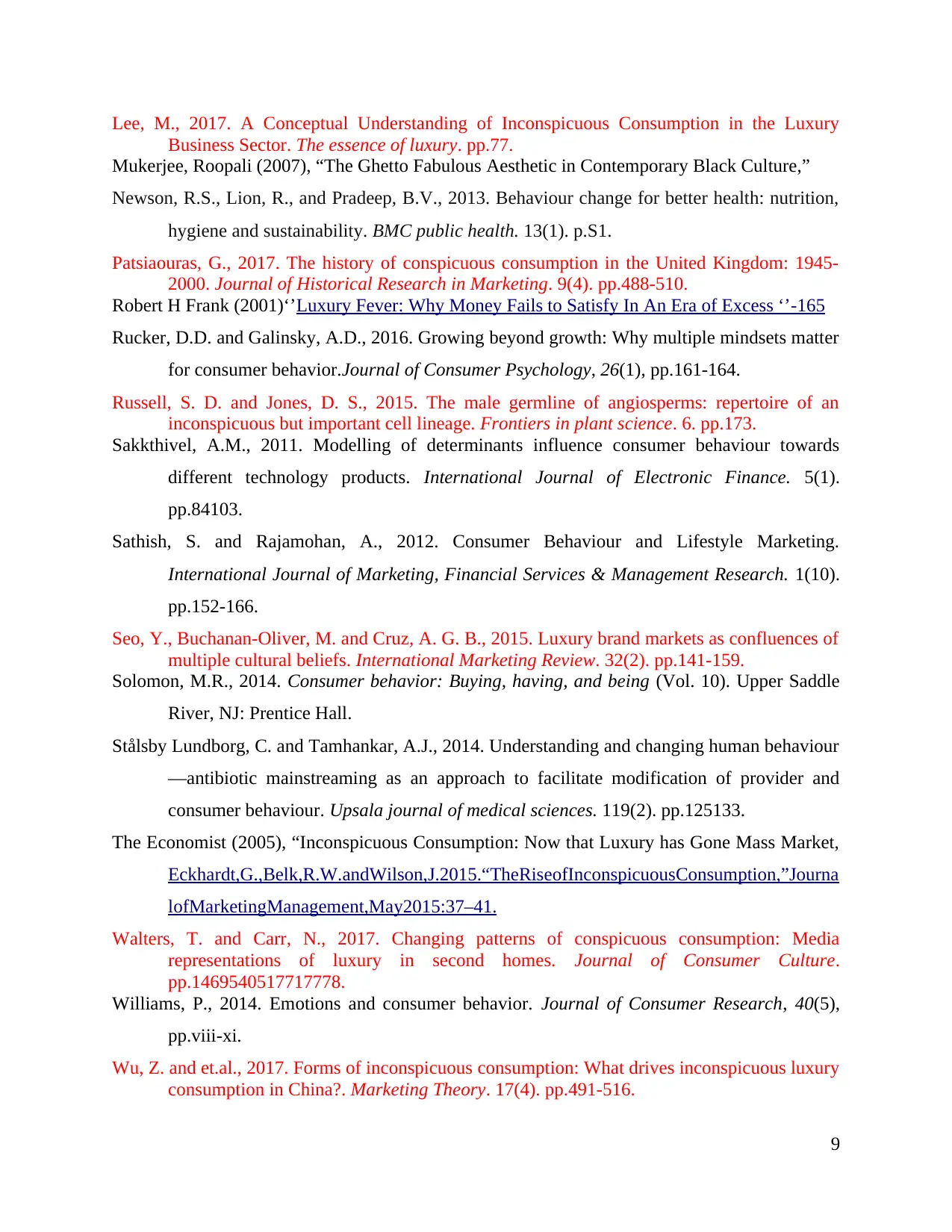
Lee, M., 2017. A Conceptual Understanding of Inconspicuous Consumption in the Luxury
Business Sector. The essence of luxury. pp.77.
Mukerjee, Roopali (2007), “The Ghetto Fabulous Aesthetic in Contemporary Black Culture,”
Newson, R.S., Lion, R., and Pradeep, B.V., 2013. Behaviour change for better health: nutrition,
hygiene and sustainability. BMC public health. 13(1). p.S1.
Patsiaouras, G., 2017. The history of conspicuous consumption in the United Kingdom: 1945-
2000. Journal of Historical Research in Marketing. 9(4). pp.488-510.
Robert H Frank (2001)‘’Luxury Fever: Why Money Fails to Satisfy In An Era of Excess ‘’-165
Rucker, D.D. and Galinsky, A.D., 2016. Growing beyond growth: Why multiple mindsets matter
for consumer behavior.Journal of Consumer Psychology, 26(1), pp.161-164.
Russell, S. D. and Jones, D. S., 2015. The male germline of angiosperms: repertoire of an
inconspicuous but important cell lineage. Frontiers in plant science. 6. pp.173.
Sakkthivel, A.M., 2011. Modelling of determinants influence consumer behaviour towards
different technology products. International Journal of Electronic Finance. 5(1).
pp.84103.
Sathish, S. and Rajamohan, A., 2012. Consumer Behaviour and Lifestyle Marketing.
International Journal of Marketing, Financial Services & Management Research. 1(10).
pp.152-166.
Seo, Y., Buchanan-Oliver, M. and Cruz, A. G. B., 2015. Luxury brand markets as confluences of
multiple cultural beliefs. International Marketing Review. 32(2). pp.141-159.
Solomon, M.R., 2014. Consumer behavior: Buying, having, and being (Vol. 10). Upper Saddle
River, NJ: Prentice Hall.
Stålsby Lundborg, C. and Tamhankar, A.J., 2014. Understanding and changing human behaviour
—antibiotic mainstreaming as an approach to facilitate modification of provider and
consumer behaviour. Upsala journal of medical sciences. 119(2). pp.125133.
The Economist (2005), “Inconspicuous Consumption: Now that Luxury has Gone Mass Market,
Eckhardt,G.,Belk,R.W.andWilson,J.2015.“TheRiseofInconspicuousConsumption,”Journa
lofMarketingManagement,May2015:37–41.
Walters, T. and Carr, N., 2017. Changing patterns of conspicuous consumption: Media
representations of luxury in second homes. Journal of Consumer Culture.
pp.1469540517717778.
Williams, P., 2014. Emotions and consumer behavior. Journal of Consumer Research, 40(5),
pp.viii-xi.
Wu, Z. and et.al., 2017. Forms of inconspicuous consumption: What drives inconspicuous luxury
consumption in China?. Marketing Theory. 17(4). pp.491-516.
9
Business Sector. The essence of luxury. pp.77.
Mukerjee, Roopali (2007), “The Ghetto Fabulous Aesthetic in Contemporary Black Culture,”
Newson, R.S., Lion, R., and Pradeep, B.V., 2013. Behaviour change for better health: nutrition,
hygiene and sustainability. BMC public health. 13(1). p.S1.
Patsiaouras, G., 2017. The history of conspicuous consumption in the United Kingdom: 1945-
2000. Journal of Historical Research in Marketing. 9(4). pp.488-510.
Robert H Frank (2001)‘’Luxury Fever: Why Money Fails to Satisfy In An Era of Excess ‘’-165
Rucker, D.D. and Galinsky, A.D., 2016. Growing beyond growth: Why multiple mindsets matter
for consumer behavior.Journal of Consumer Psychology, 26(1), pp.161-164.
Russell, S. D. and Jones, D. S., 2015. The male germline of angiosperms: repertoire of an
inconspicuous but important cell lineage. Frontiers in plant science. 6. pp.173.
Sakkthivel, A.M., 2011. Modelling of determinants influence consumer behaviour towards
different technology products. International Journal of Electronic Finance. 5(1).
pp.84103.
Sathish, S. and Rajamohan, A., 2012. Consumer Behaviour and Lifestyle Marketing.
International Journal of Marketing, Financial Services & Management Research. 1(10).
pp.152-166.
Seo, Y., Buchanan-Oliver, M. and Cruz, A. G. B., 2015. Luxury brand markets as confluences of
multiple cultural beliefs. International Marketing Review. 32(2). pp.141-159.
Solomon, M.R., 2014. Consumer behavior: Buying, having, and being (Vol. 10). Upper Saddle
River, NJ: Prentice Hall.
Stålsby Lundborg, C. and Tamhankar, A.J., 2014. Understanding and changing human behaviour
—antibiotic mainstreaming as an approach to facilitate modification of provider and
consumer behaviour. Upsala journal of medical sciences. 119(2). pp.125133.
The Economist (2005), “Inconspicuous Consumption: Now that Luxury has Gone Mass Market,
Eckhardt,G.,Belk,R.W.andWilson,J.2015.“TheRiseofInconspicuousConsumption,”Journa
lofMarketingManagement,May2015:37–41.
Walters, T. and Carr, N., 2017. Changing patterns of conspicuous consumption: Media
representations of luxury in second homes. Journal of Consumer Culture.
pp.1469540517717778.
Williams, P., 2014. Emotions and consumer behavior. Journal of Consumer Research, 40(5),
pp.viii-xi.
Wu, Z. and et.al., 2017. Forms of inconspicuous consumption: What drives inconspicuous luxury
consumption in China?. Marketing Theory. 17(4). pp.491-516.
9
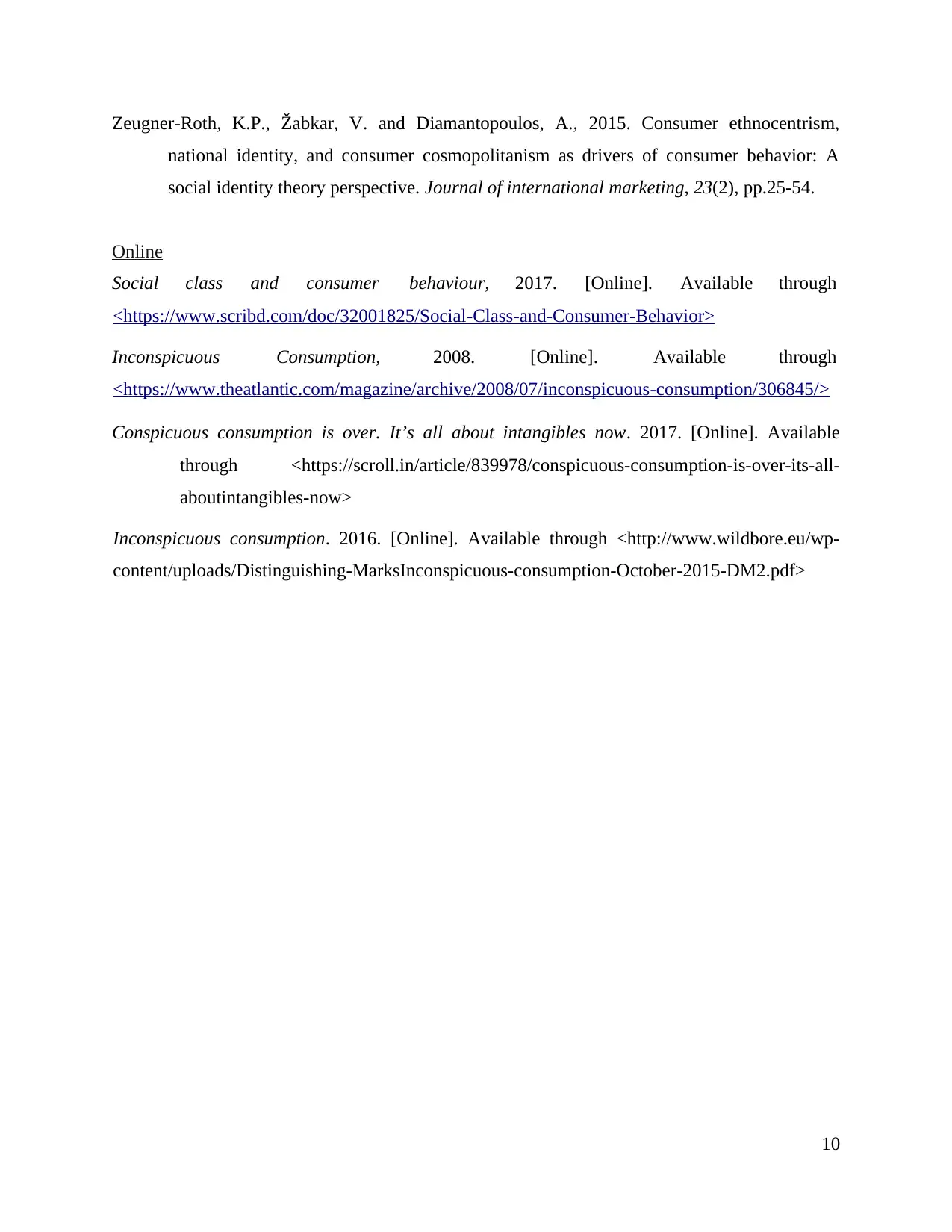
Zeugner-Roth, K.P., Žabkar, V. and Diamantopoulos, A., 2015. Consumer ethnocentrism,
national identity, and consumer cosmopolitanism as drivers of consumer behavior: A
social identity theory perspective. Journal of international marketing, 23(2), pp.25-54.
Online
Social class and consumer behaviour, 2017. [Online]. Available through
<https://www.scribd.com/doc/32001825/Social-Class-and-Consumer-Behavior>
Inconspicuous Consumption, 2008. [Online]. Available through
<https://www.theatlantic.com/magazine/archive/2008/07/inconspicuous-consumption/306845/>
Conspicuous consumption is over. It’s all about intangibles now. 2017. [Online]. Available
through <https://scroll.in/article/839978/conspicuous-consumption-is-over-its-all-
aboutintangibles-now>
Inconspicuous consumption. 2016. [Online]. Available through <http://www.wildbore.eu/wp-
content/uploads/Distinguishing-MarksInconspicuous-consumption-October-2015-DM2.pdf>
10
national identity, and consumer cosmopolitanism as drivers of consumer behavior: A
social identity theory perspective. Journal of international marketing, 23(2), pp.25-54.
Online
Social class and consumer behaviour, 2017. [Online]. Available through
<https://www.scribd.com/doc/32001825/Social-Class-and-Consumer-Behavior>
Inconspicuous Consumption, 2008. [Online]. Available through
<https://www.theatlantic.com/magazine/archive/2008/07/inconspicuous-consumption/306845/>
Conspicuous consumption is over. It’s all about intangibles now. 2017. [Online]. Available
through <https://scroll.in/article/839978/conspicuous-consumption-is-over-its-all-
aboutintangibles-now>
Inconspicuous consumption. 2016. [Online]. Available through <http://www.wildbore.eu/wp-
content/uploads/Distinguishing-MarksInconspicuous-consumption-October-2015-DM2.pdf>
10
⊘ This is a preview!⊘
Do you want full access?
Subscribe today to unlock all pages.

Trusted by 1+ million students worldwide
1 out of 12
Related Documents
Your All-in-One AI-Powered Toolkit for Academic Success.
+13062052269
info@desklib.com
Available 24*7 on WhatsApp / Email
![[object Object]](/_next/static/media/star-bottom.7253800d.svg)
Unlock your academic potential
Copyright © 2020–2025 A2Z Services. All Rights Reserved. Developed and managed by ZUCOL.




